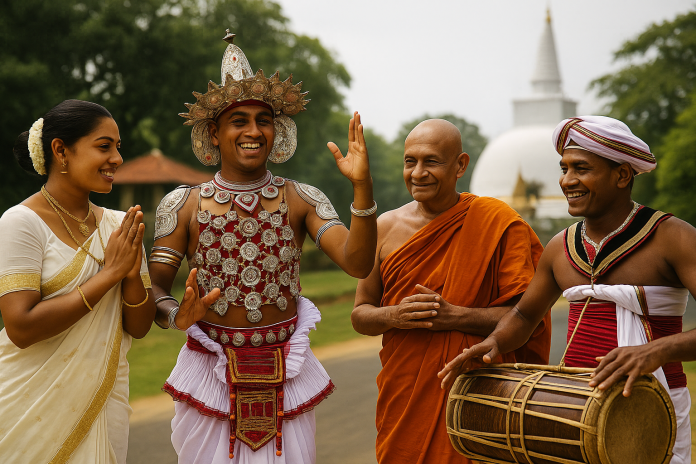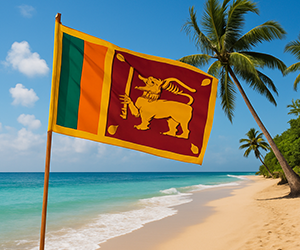1. Introduction to Sri Lankan Culture
Sri Lanka, known as the Pearl of the Indian Ocean, is a country with a rich cultural heritage that spans over two millennia. Its vibrant traditions, deep-rooted values, and unique customs reflect a tapestry of influences shaped by geography, history, religion, and ethnicity. From ancient Buddhist practices to Tamil Hindu rituals and colonial legacies, Sri Lankan culture is a harmonious blend of the old and the new.
Culture in Sri Lanka is not confined to art or tradition—it is a way of life. Whether it’s through colorful festivals, traditional dance forms, or culinary delicacies, the culture reflects the identity and spirit of its people. For locals, it defines daily life and social interactions, and for visitors, it offers a unique window into the heart of the island nation.
2. Historical Evolution of Culture in Sri Lanka
The cultural history of Sri Lanka dates back to prehistoric times with the evidence of early human settlements in places like Balangoda. As the island evolved into a major trade hub, it became a melting pot of diverse influences.
Ancient kingdoms like Anuradhapura and Polonnaruwa were not only political centers but also cultural beacons. These cities flourished with advancements in architecture, irrigation, and spiritual life. With the introduction of Buddhism in the 3rd century BCE, Sri Lankan culture experienced a transformative influence that still persists today.
Later, the arrival of South Indian dynasties, Arab traders, Portuguese, Dutch, and British colonizers added new layers to the island’s cultural identity. This fusion has given rise to a society where multiple traditions coexist peacefully, creating a vibrant and resilient cultural fabric.
3. Religion and Its Influence on Culture
Religion is a cornerstone of Sri Lankan culture. The majority practice Theravāda Buddhism, which shapes the island’s values, education, and festivals. Important Buddhist temples like the Temple of the Tooth Relic in Kandy are both religious and cultural landmarks.
Hinduism, primarily practiced by the Tamil community, is equally vibrant. Hindu temples or “kovils” such as the Nallur Kandaswamy Temple in Jaffna reflect deep devotion through architecture, rituals, and festivals like Deepavali.
Christianity and Islam also play significant roles. Colonial influences introduced Catholicism and Protestantism, while Arab traders brought Islam. Churches and mosques are prominent in many regions, particularly in coastal areas. The coexistence of multiple religions has led to interwoven traditions, mutual respect, and shared cultural spaces.
- Keywords: Buddhism in Sri Lanka, Sri Lankan religious culture, temples in Sri Lanka
4. Festivals and Celebrations
Sri Lanka is a land of festivals, each marked by joy, spirituality, and community participation. The most widely celebrated is the Sinhala and Tamil New Year, held in April. It signifies the harvest and the transition of the sun from Pisces to Aries. Customs include oil anointing, lighting the hearth, and traditional games.
Vesak, commemorating the birth, enlightenment, and passing of the Buddha, transforms the country into a spectacle of lights, lanterns, and acts of charity. Poson, particularly celebrated in Anuradhapura, honors the arrival of Buddhism to Sri Lanka.
Deepavali, the Hindu festival of lights, and Ramadan for Muslims, bring together communities in celebration, reflection, and sharing. Christmas is celebrated not only by Christians but by many Sri Lankans who enjoy the festivities.
The Esala Perahera in Kandy is one of Asia’s grandest pageants, featuring traditional dancers, drummers, and tusked elephants in honor of the sacred Tooth Relic.
- Keywords: Sri Lankan festivals, Vesak festival, Sinhala Tamil New Year, cultural celebrations Sri Lanka
5. Language, Literature, and Folklore
Sri Lanka is officially trilingual with Sinhala, Tamil, and English widely used. Sinhala and Tamil are the dominant languages with rich literary traditions.
Ancient texts like the “Mahavamsa” and “Culavamsa” in Pali and Sinhala document the island’s history and Buddhist philosophy. Tamil literature has flourished through devotional poetry, epics, and modern novels.
Sri Lanka is also home to a vibrant oral tradition. Folk tales like “Mahadenamutta,” stories of kings, and local legends are passed down through generations, often teaching moral lessons or historical context.
- Keywords: Sri Lankan literature, Sinhala stories, Tamil folklore, folk culture Sri Lanka
6. Traditional Arts, Dance, and Music
The island’s traditional arts reflect religious and social life. Kandyan dance is the most iconic, featuring acrobatic movements, elaborate costumes, and ceremonial drums. Low country and Sabaragamuwa dance styles are rooted in ritualistic and healing traditions.
Drumming is integral, with instruments like the “Geta Bera” and “Yak Bera” used in festivals and rituals. Music blends folk, classical, and modern influences.
Art forms such as wood carving, mask making, and batik painting are prominent in regions like Ambalangoda and Kandy. Puppetry and traditional theater continue to entertain and educate rural communities.
- Keywords: Sri Lankan traditional dance, Kandyan dance, Sri Lankan music, cultural art Sri Lanka
7. Architecture and Cultural Sites
Sri Lanka’s architecture is a visual narration of its cultural journey. Anuradhapura and Polonnaruwa feature monumental stupas and intricate carvings from the island’s golden eras. Sigiriya, the Lion Rock Fortress, is a marvel of ancient urban planning and art.
Religious architecture is deeply symbolic. Dagobas (stupas) represent enlightenment, while Hindu kovils, with their colorful gopurams, reflect divine presence. Colonial buildings in Galle, Colombo, and Nuwara Eliya showcase Dutch, Portuguese, and British architectural styles.
- Keywords: Sri Lankan architecture, Sigiriya culture, cultural sites Sri Lanka
8. Sri Lankan Traditional Attire and Dress Codes
Traditional attire in Sri Lanka varies by ethnicity and occasion. The Kandyan saree or “Osariya” is worn by Sinhalese women during formal events and weddings. Tamil women wear sarees in unique draping styles, often brightly colored and adorned with jewelry.
Men often wear the sarong, a wraparound garment paired with a shirt. In religious ceremonies, white is commonly worn to symbolize purity.
While Western clothing is widespread in daily life, traditional attire remains significant during festivals and formal gatherings.
- Keywords: Sri Lankan traditional dress, Kandyan saree, Sri Lankan fashion
9. Food Culture and Culinary Traditions
Sri Lankan cuisine is a celebration of spice, flavor, and diversity. Rice and curry is the staple meal, often served with dhal, vegetables, fish, or meat. The use of coconut, chili, cinnamon, and curry leaves defines the cuisine.
Popular dishes include:
- Hoppers (appa): Bowl-shaped pancakes, sometimes with egg
- Kottu Roti: Stir-fried chopped roti with vegetables, egg, or meat
- String hoppers (idi appa): Steamed rice noodles served with curry
Sweets like kokis, aluwa, and mung kavum are integral to festive meals. Eating with the right hand, sharing meals, and offering food to guests are cultural norms that reflect hospitality.
- Keywords: Sri Lankan food culture, traditional Sri Lankan cuisine, Sri Lankan cooking
10. Family Life, Values, and Social Customs
Family is the core of Sri Lankan society. Respect for elders, close-knit family ties, and community support are fundamental values. Multi-generational households are common, and elders often play key roles in decision-making.
Arranged marriages remain a tradition, although modern attitudes are gaining ground. Hospitality is a cornerstone—visitors are warmly welcomed, and sharing meals is a customary gesture.
Social customs vary slightly between communities but emphasize respect, modesty, and cooperation.
- Keywords: Sri Lankan family culture, social customs Sri Lanka, values in Sri Lankan society
11. Sri Lankan Culture in the Modern Era
With globalization, urbanization, and digital transformation, Sri Lankan culture is evolving. Cities are experiencing a fusion of East and West, with traditional practices adapting to contemporary lifestyles.
Youth are active in preserving culture through arts, digital storytelling, and tourism. However, there are concerns about cultural dilution. Organizations and educators emphasize the importance of teaching cultural heritage in schools and communities.
- Keywords: modern Sri Lankan culture, youth and culture Sri Lanka, cultural preservation Sri Lanka
12. Conclusion: The Living Soul of Sri Lanka
Sri Lankan culture is not a relic of the past; it is a living, breathing essence that continues to evolve while preserving its roots. It is visible in the way people greet each other, cook meals, dress, and celebrate life.
As the world becomes more connected, the importance of cultural identity becomes even more vital. For Sri Lanka, culture is not just history—it is the heartbeat of the nation. Preserving and promoting this rich heritage ensures that future generations will continue to take pride in their unique identity.
- Keywords: cultural identity Sri Lanka, Sri Lankan heritage, preserving culture




